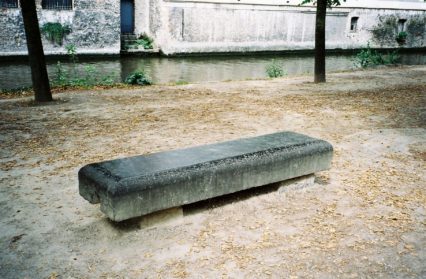In a time of social isolation and lockdown, architect and author Richard Porch shares his thoughts on the humble public bench.
There can be fewer more unregarded and generally invisible items of street furniture than the humble bench. They are even less regarded than gateposts, bus shelters or lamp posts and that’s (with my best anorak on) saying something. The general design of them has improved over the last 30 years as the recognition that the design of street furniture (to use an all-embracing term) actually matters. And it does of course. Although the choice of street furniture is almost the smallest in a long sequence of decisions that gets made about the built environment, it begins with land use, architecture, infrastructure design and landscaping, it can be very important.
Perhaps it is because we are so used to seeing them and always expect them to be there that we just don’t give them any attention. They are above all a nice civic consideration on the part of whoever owns the land on which they rest; whether it is the local council or a property developer. Being able to sit down and take in passing events, eat a sandwich or have a civilised conversation with someone is facilitated by benches.
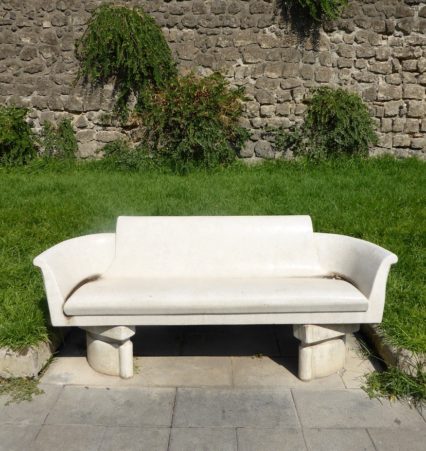
So, does it matter what they look like? Of course there are purely practical considerations which must govern their appearance, to an extent. Such as; being able to carry a weight over and above what the seating notionally allows for, be weatherproof, vandal-resistant and (ideally) be susceptible to being cleaned. Looking at the benches designed and manufactured by modern manufacturers over the last three decades, most have managed to have accommodate these constraints, albeit at the expense of sacrificing any sense of character or location. Many have become merely environmentally-scaled pieces of product design, available from this or that manufacturers catalogue.
It would far better for the genius loci if they were designed by local craftsmen, artists or designers, if possible using local materials. Using this approach, the design grows out of the nature of the material being used. The end result might be primitive looking but in the best sense of the word i.e. it was no more than it needed to be or executed as the great German industrial designer Dieter Rams (b.1932) once recommended, “with as little design as possible”. By that he meant that the design-outcome should be; unobtrusive, honest, durable, thorough and its production should be environmentally friendly and not geared to product redundancy or (worse) be fashion statements.
I saw some stone public bench seating provided for visitors to the Giardini La Mortella botanic garden on the Italian island of Ischia that met all the criteria mentioned above. They were in a local volcanic stone that was no more than some cut blocks to form legs and a rectangular slab across them to provide for a rugged seat. They looked a bit like they owed something to the Flintstones but were free of any designerly obsessions or design rhetoric. Their functionalism was sincere and founded on decisions about the most direct and efficient way to use the material. They could tolerate any amount of extra weight, could be cleaned down or power-washed to remove graffiti and would soon dry out if rained on. Admittedly they were completely context-dependent in that they would probably not look right almost anywhere else, but that’s an asset not a defect.
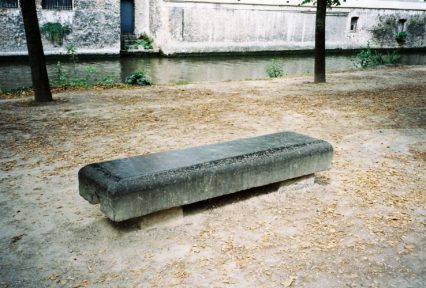
I saw another monolithic public bench of this kind in Bruges beside a canal there. By contrast this seemed more self-consciously designed, was made of concrete and had a chamfered top edge as some sort of concession to user comfort. It somehow looked more arty and was low on the ground so that one crouched rather than sat comfortably on it. There was a vague feeling that it was designed to be ambiguously both a seat and type of minimalist sculptural artwork and that’s precisely the way it came across. I’ve seen this approach employed and it’s a common problem caused by designers who want to make something look somehow un-designed yet be actually completely the opposite. Now there’s an irony at work if ever there was one.
I saw a similar kind of approach taken with a public bench located outside a small conference centre 3000 ft. up in the Romdal or the Norwegian Alps. It was no more than a block of Baltic Pine cut down, planed and left as a simple block of wood. All one could do was sit on it; but taken with the similarly primitive detailing of the building it butted up against, it could be understood as a genuinely rustic statement. Not a single extra thing had been done to it to add decoration and it rested on two simple 2” x 4” timber blocks that lifted it clear of the floor. So was it a design statement in keeping with simplicity of the rest of the building or was it just that the budget ran out at that point? I think it was the former and that anything else would have been inconsistent and drawn attention away from the building itself.
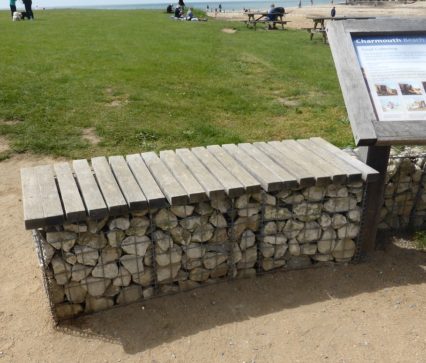
Whilst on a visit to Charmouth in Devon to look for fossils I saw a wonderfully simple design for a bench that one really had to look twice at to check it was a bench. It was made from three gabions (strong wire cages used normally for reinforcing in landscape design) and packed with local stone to stabilise the whole. The actual seat was nothing more than stout timber slats screw or nailed to a hidden frame. As such it was comfortable enough, rugged and durable as the materials of its construction allowed for.
On another level entirely and in the Italian resort town of Sorrento can be found public seating at the other end of the aesthetic spectrum. For, in a location near the ancient town walls (made of the local volcanic stone) and hence a site of some heritage value, have been installed some distinctive street furniture. Now, I’m prepared to concede this may be an adventurous statement on behalf of Sorrento’s town council, completely intentional and with the civic tongue planted firmly in its cheek. It might also be a lapse of taste that nevertheless brings a smile to the face. The seats were in a moulded concrete and looked like someone had set out to manufacture a conventional sofa on a fibre-glass frame and then forgot to put the upholstery on. They then thought sod it – let’s make it in concrete instead.
The result has a vaguely surreal air about it. As if someone had taken one of those inside-out sculptural works by Rachel Whiteread and instead of using the negative space just used the positive. Full marks to them though. In Britain we’d have chosen something in cast-iron, black and with stained timber seats because it was a heritage setting. What they’ve done looks as though DFS has moved into street furniture and gone for a comfortable suburban look. The seats were very comfortable although I noticed problems with staining caused by rain because they were not draining rain away properly.
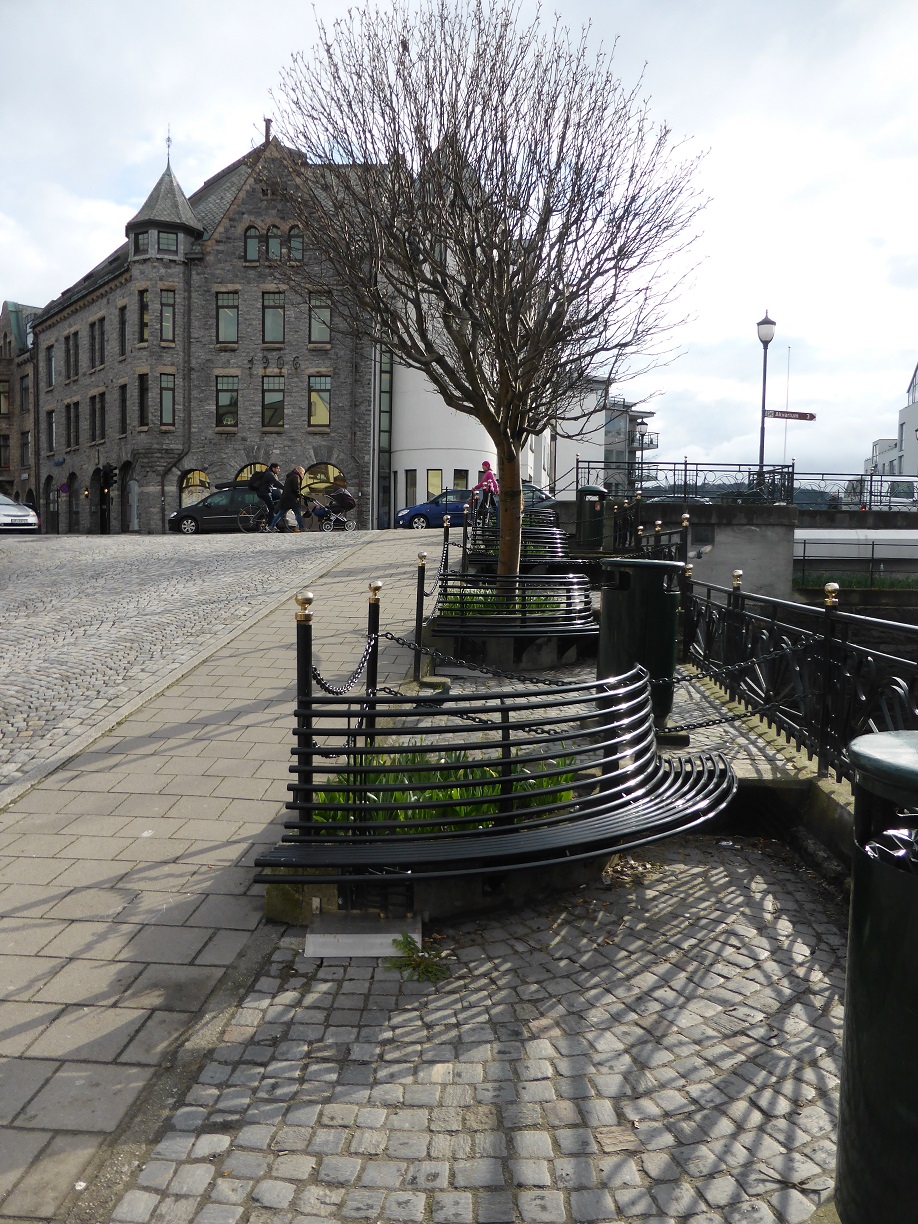
The most comforting seats I’ve ever used came from the Norwegian fishing port of Ålesunde. Here they thoughtfully laid out a row of electrically heated public seats in the inevitable civic black finish. The bitterly cold Norwegian winters coupled to their location immediately adjacent to the town’s key tourist destination (an entire district comprised exclusively of Jugendstil architecture) were the two main drivers behind their deployment. They are nothing to look at and at first glance resemble a very basic tubular seat made for tourists to rest on. Upon plonking oneself down though one became instantly aware that there was heat coming through the tubes and they were pleasantly warm to the touch. This was revivifying and hence made one want to linger all of which is surely (in the long run) good for the local economy. It demonstrated a level of sensitivity for the user which is frankly rare in street furniture design. I’d like to think they were heated by thermal core accessed by a deep bore hole into the ground beneath Ålesunde, but I’m not sure.
So beware, the design of public seating is an important badge of civic pride and the quality of its design (or lack of it) can say a lot about a town or city.
Richard Porch is a regular contributor at Wales Arts Review.
_______________________________________________________________________
Recommended for you:
Walking | Idle Thoughts of an Idling Fellow
Nigel Jarrett went out walking in his local area almost every day after the first lockdown ended. It was an experience.
_______________________________________________________________________


